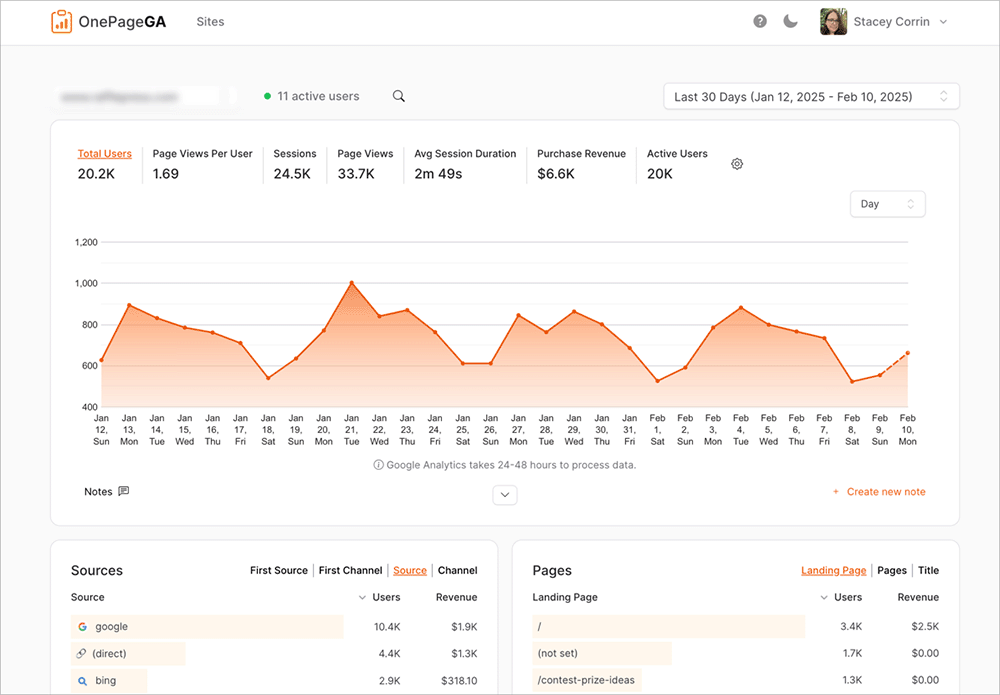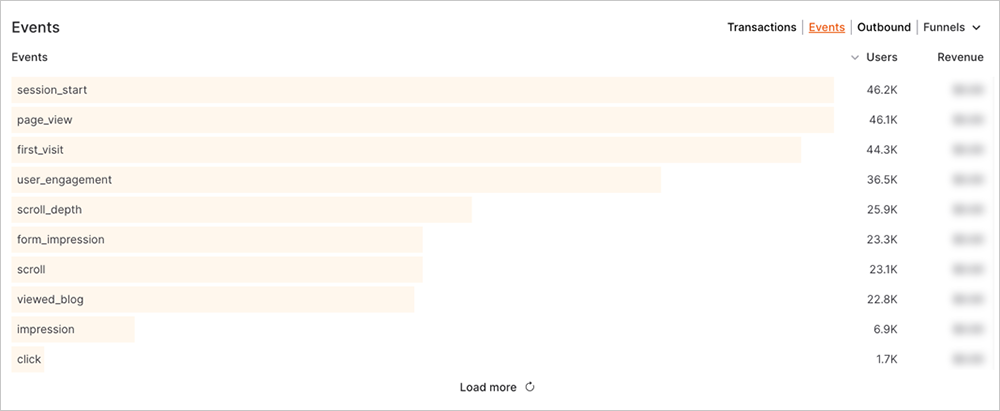Opening GA4 for the first time can feel like stepping into another language. One of the first things you’ll see are “events,” and they’re the core of how GA4 works.
In GA4, events record every action a visitor takes, from clicking a button to watching a video. They’ve replaced the old way of tracking in Universal Analytics, so understanding them isn’t optional. GA4 is already used on about 14.8 million websites worldwide, roughly 43% of all Google Analytics sites, making it the new standard.
In this guide, I’ll explain what are GA4 events, the different types you’ll see, and which ones are worth tracking so you can focus on the data that matters.
What Are GA4 Events?
GA4 events are how Google tracks every action a visitor takes on your site or app. Clicks, page views, scrolls, and form submissions, for instance are all now recorded as events.
There are no more separate hit types like in Universal Analytics. Every interaction is now treated the same way, with extra details added through parameters.

For example, a button click is logged as a click event, and parameters can show which button was clicked or where it happened. This new approach makes it easier to track and compare different user actions in one place.
GA4 vs Universal Analytics: What Changed?
The biggest change is that GA4 doesn’t use different hit types like pageviews, events, and transactions. In Universal Analytics, each interaction had its own category, action, and label structure.
In GA4, every interaction is simply an event. That means a pageview, a video play, and a purchase are all tracked the same way, just with different event names and parameters.
You also don’t need Google Tag Manager for many basic events. GA4 can automatically track common actions like clicks and scrolls once you turn on Enhanced Measurement in your Data Stream settings.
This event-based model makes it easier to compare actions side by side and build custom reports without juggling multiple tracking methods.
| Feature | Universal Analytics (UA) | Google Analytics 4 (GA4) |
|---|---|---|
| Tracking model | Different hit types (pageviews, events, transactions) | Everything is an event |
| Event structure | Category, Action, Label | Event name + parameters |
| Basic event tracking | Often required Google Tag Manager | Many tracked automatically via Enhanced Measurement |
| Reporting | Separate reports for each hit type | Unified reports for all events |
For more details, here’s an easy guide to how Google Analytics 4 works.
What Are Event Parameters in GA4?
Event parameters are extra details that describe an event, such as what was clicked or which page was viewed. They add context so you know more than just the action itself.
Earlier, we saw that GA4 tracks every interaction as an event. Parameters work alongside these events to capture specifics.
For example:
- A
page_viewevent might include apage_locationparameter with the exact URL visited. - A
clickevent could have alink_urlparameter showing which link was clicked.
GA4 allows up to 25 custom parameters per event, compared to just 4 in Universal Analytics. This extra detail is especially useful when you’re tracking conversions or building audiences based on precise actions.
What Are the Different Types of GA4 Events?
GA4 groups events into four main types. Some are tracked automatically, while others need to be turned on or created manually.
| Type of Event | What It Does | Examples |
|---|---|---|
| Automatically collected | Tracked as soon as GA4 is set up, no extra configuration needed | page_view, first_visit, session_start |
| Enhanced Measurement | Optional built-in events you can turn on in your Data Stream settings | scroll, file_download, view_search_results |
| Recommended | Predefined by Google for specific use cases; must use exact names and parameters | add_to_cart, sign_up, purchase |
| Custom | Created by you to track unique actions not covered by other event types | Form submission, specific CTA click, custom funnel step |
- Automatically collected events — tracked from the moment you set up GA4, such as
page_vieworfirst_visit. - Enhanced Measurement events — built-in options you can enable to track actions like
scrollorfile_download. - Recommended events — predefined by Google for things like ecommerce or sign-ups, which you need to set up using exact names and parameters.
- Custom events — created by you to track unique actions that are not covered by the other types.
If you want examples and setup details for each one, see my detailed guide on the types of events in GA4.
Which GA4 Events Should You Track?
Not every event in GA4 is worth monitoring. The most useful setup is one that focuses on actions that move you closer to your goals, whether that is getting more leads, sales, or engaged readers.
Here are the ones I typically prioritize on most sites I work with:
- Form submissions — track when visitors complete contact forms, quote requests, or newsletter signups. These are strong signals of interest and potential conversions.
- Button clicks — especially for your main call-to-action buttons like “Sign Up,” “Book a Demo,” or “Download Guide.” These clicks often mark the start of your sales funnel.
- Add to cart and checkout — for ecommerce, these events show buying intent and help identify where customers drop off before purchasing.
- Scroll — GA4’s built-in
scrollevent fires when a visitor reaches 90% of a page. This can be a quick way to see if users are making it to the end of your most important content. - Conversion actions — any event you have marked as a conversion in GA4. This could be a purchase, form submission, booking confirmation, or other revenue-related action.
Events you don’t need to prioritize include things like every outbound link click or generic file downloads, unless they directly support your business goals.
A smart approach is to start with one event per goal. Once you’re confident you are getting clean, useful data, you can expand your tracking to capture other meaningful actions.
How to View Events in GA4
You can see all the events GA4 is tracking in the Reports section. Go to Reports » Engagement » Events to view the list.

The table shows each event name along with how many times it happened. If you’ve marked an event as a conversion, you’ll also see a column showing how many conversions it generated.
For testing or troubleshooting, open Admin » DebugView. This shows events in real time so you can confirm your tracking is working correctly.

Remember, an event has to fire at least once before it appears in your reports.
For more help, you can see this guide on how to set up simple Google Analytics reports.
How to Make GA4 Event Tracking Easier
GA4’s event reports can feel overwhelming, especially if you’re not used to handling multiple menus and filters. It can take time to find the numbers you need and even longer to turn them into something useful.
If you want a simpler view, you can use a tool like OnePageGA to see your most important events in one place.

OnePageGA is a simple, single-page Google Analytics dashboard built for people who don’t have time to dig through GA4. It pulls your most useful metrics, such as top events, conversions, traffic sources, and engagement, into one clear report.

More importantly, you don’t need to set up custom explorations or learn GA4’s complicated navigation.
With OnePageGA, you can quickly check:
- Your top events by volume
- Which events are marked as conversions
- Key actions like clicks, scrolls, and form fills

Instead of building custom reports, you get a clean dashboard that shows you exactly what is working without the extra noise.
FAQs About GA4 Events
What are GA4 events used for?
GA4 events track what users do on your site, such as viewing pages, clicking links, scrolling, and completing conversions. They help you see which actions drive engagement and results.
What’s the difference between GA4 and Universal Analytics events?
In Universal Analytics, events were just one type of hit alongside pageviews and transactions. In GA4, every interaction is tracked as an event.
Do I need Google Tag Manager to track events?
Not for basic tracking. Many events are collected automatically or through Enhanced Measurement. You only need Tag Manager for custom or advanced tracking.
What are GA4 event parameters?
Event parameters are extra details that describe an event, such as which link was clicked or the page URL viewed. They add context so you can understand more than just the action itself.
How do I mark something as a conversion in GA4?
Go to Admin » Events, then turn on “Mark as conversion” next to the event name you want to count as a conversion.
Making GA4 Events Work for You
Understanding GA4 events is the key to making sense of your analytics. When you know which actions matter and how to track them, you can focus on changes that actually improve your site’s performance.
You don’t need to track everything. Start with the events that align with your goals, keep your data clean, and build from there.
If you want to see your most important events at a glance without digging through GA4, OnePageGA brings them together in a clear, single-page dashboard so you can make faster, better decisions.
You may also find the following GA4 guides helpful:

